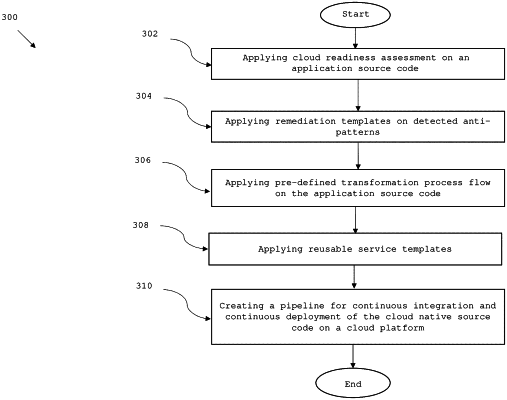| CPC G06F 11/3692 (2013.01) [G06F 8/61 (2013.01); G06F 11/3676 (2013.01); G06F 11/3688 (2013.01); H04L 67/01 (2022.05); G06F 8/10 (2013.01); G06F 8/20 (2013.01); G06F 8/35 (2013.01); G06F 8/40 (2013.01); G06F 8/43 (2013.01); G06F 8/45 (2013.01); G06F 8/60 (2013.01); G06F 8/65 (2013.01); G06F 21/577 (2013.01); H04L 41/0886 (2013.01); H04L 41/145 (2013.01); H04L 41/5048 (2013.01); H04L 67/10 (2013.01); H04L 67/148 (2013.01)] | 18 Claims |

|
1. A system for application transformation to cloud by conversion of an application source code to a cloud native code, the system comprising:
a memory storing program instructions; a processor configured to execute program instructions stored in the memory; and an application transformation to cloud engine executed by the processor and configured to:
receive a first and a second transformation recommendation paths;
apply a set of remediation templates based on the first and the second transformation recommendation paths, wherein the set of remediation templates comprises pre-defined parameterized actions;
build definition of classes of the application source code;
apply a pre-defined transformation process flow on the application source code based on the first and the second transformation recommendation paths to transform the application source code to the cloud native code; and
apply a reusable service template on the application source code, based on the first and the second transformation recommendation paths, wherein the reusable service template applies repeatable code changes required for integration and deployment of the cloud native code to a cloud platform, wherein the system comprises a microservices unit configured to optimize assessment and implementation of microservices code for multiple target cloud platforms by:
determining a count of microservices anti-patterns in a microservices code, wherein the microservices anti-patterns represent a pattern of the microservices code which is not compatible with a target cloud platform and is not aligned with industry best practices on developing microservices architecture;
ascertaining a current state of the microservices code by determining a maturity score, wherein the maturity score is indicative of an extent to which characteristics associated with the microservices code is aligned with predetermined microservices architecture characteristics; and
providing a set of repeatable steps associated with microservices code development in a bundled form for accelerated implementation of changes in the microservices code for deployment on the multiple target cloud platforms.
|